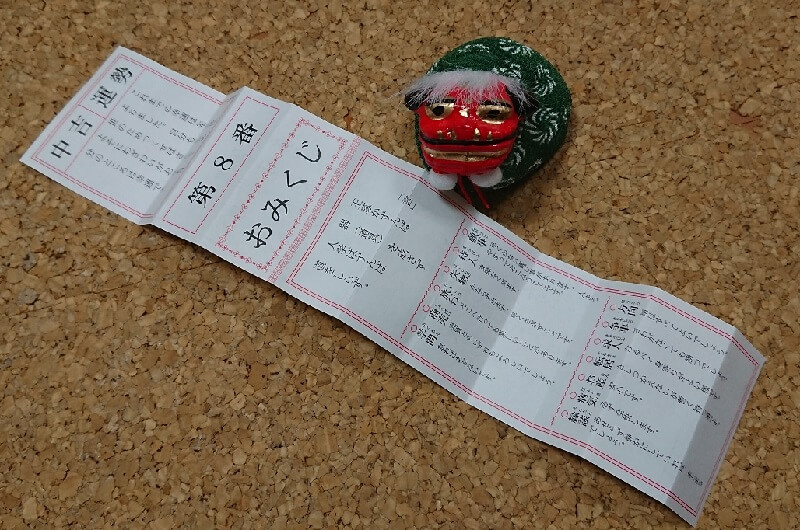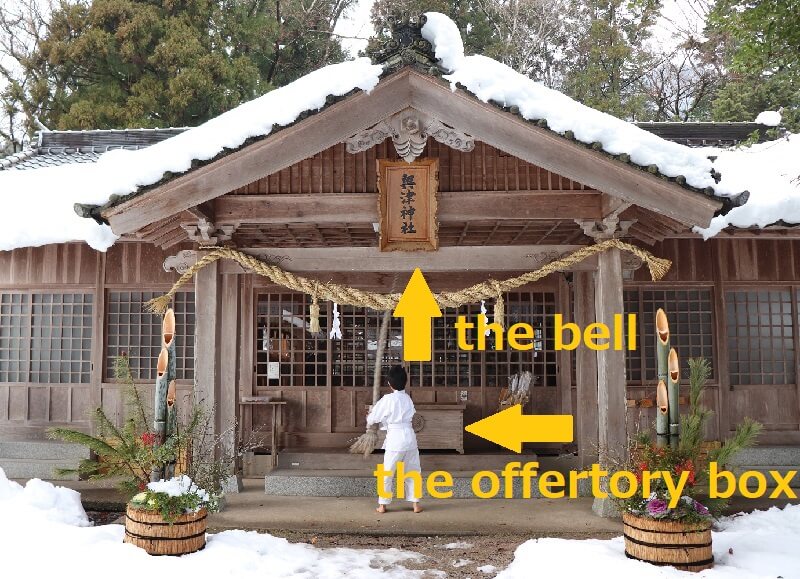
I went to Okutsu shrine for Hatsumode.
ボクは奥津神社に初詣に行った。
What is “Hatsumode”(初詣とは)
Hatsumode is an important event in New Year in Japan.
初詣は新年の大事なイベントです。
It is the custom of visiting a shrine to offer the first prayer of the New Year.
初詣とは新年に初めて神社に行ってお祈りすることです。
Mast Japanese have no religion.
ほとんどの日本人は無宗教です。
But Japanese visit a shrine in New Year.
でも、日本人はお正月に神社へお詣りします。
Let’s visit a shrine(初詣に行こう)
Anyone can visit a shrine.
誰でも神社へお詣りできます。
You can do a lot of things at Hatsumode.
初詣では様々なことができます。
- Prayer(参拝)
- Omikuji(おみくじ)
- Ema(絵馬)
- Omamori(御守り)
- Yatai(屋台)
- Omiki(御神酒)
Prayer(参拝)
You pray for good fortune to come…health, happiness, and so on.
幸運(健康や幸せなど)を祈ります。
Omikuji(おみくじ)

Omikuji means a fortune slip.
おみくじとは占いの一種です。
Japanese people draw a Omikuji to read their fortune in Hatsumode.
初詣でおみくじをひいて1年を占います。
The best fotune is “dai-kichi” and the worst one is “dai-kyo”.
おみくじで一番いいのが大吉、一番悪いのが大凶です。
- dai-kichi
大吉 - chu-kichi
中吉 - kichi
吉 - sho-kichi
小吉 - sue-kichi
末吉 - kyo
凶 - dai-kyo
大凶
If you get “dai-kyo” , tie it up in the trees there and you’ll be all right.
もし大凶が出ても、おみくじを境内の木に結べばいいと言われています。
Ema(絵馬)
Ema means a votive horse tablet.
絵馬は馬の絵が描かれた板です。
It is said that if you write your wish on the ema and dedicate it, your wish come true.
絵馬に願い事を書いて奉納すると、願いが叶うと言われています。
Omamori(御守り)
Omamori means an amulet.
御守りです。
You can buy omamori anytime in shrine.
御守りはいつでも神社でいただくことができます。
But a lot of people buy it in Hatsumode.
だけど、初詣で買う人が多いです。
Yatai(屋台)
Yatai means Street stalls.
屋台です。
Many kinds of stands form a line on the approach to a shrine at Hatsumode.
※only big shrine
大きな神社では、初詣のときにたくさんの種類の屋台が参道にならびます。
Omiki(御神酒)
Omiki means sacres sake.
御神酒はお酒です。
Some shrine give omiki for free at Hatsumode.
※only over 20 years old.
神社によっては初詣のときに無料で御神酒をふるまっています。
※20歳以上だけ
Drinking omiki is thought to get help from the god.
御神酒をいただくと、神の御加護があるといわれています。
About shrine(神社について)
The shrine is called “Jinja” in Japan.
日本語では神社と言います。
They enshrine Shinto deities.
神道の神様が祀られています。
We have a lot of shrines in Japan.
日本にはたくさんの神社があります。
Shinto rituals are held there, such as weddings, festivals and rituals to pray for the growth of children.
神社では、結婚式、お祭り、子供の成長を願う儀式などが行われます。
How to pray(参拝の仕方)

It’s the entrance in Okutsu-shrine.
奥津神社の入口です。
The entrance of shrine has some “Torii”.
神社の入口には「鳥居」があります。
Shrin gates are called “Torii”.
神社の門のことを「鳥居」と言います。
1.Chozuya~purify yourself(手水舎で清める)
You go to “chozuya”,you pass through the shrine gates at first.
まず最初に、鳥居をくぐったら手水舎に行きます。
And wash your hands and rinse yout mouth.
手を洗い、口をゆすぎます。
How to use a chozusha(手水舎の使い方)
 It’s a “chozuya”
It’s a “chozuya”
1.You take one of the ladles by your right hand, fill it with water, and rinse the left hand by pouring some of the water over the hand.
右手で柄杓に水をくみ、左手を洗います。
2.You grasp the ladle with your left hand, fill it with water, and rinse the right hand by pouring some of the water over the hand.
柄杓を左手に持ちかえ、右手を洗います。
3. You grasp the ladle with your right hand again, fill some of the remaining water in the cupped left hand, and rinse the mouth
柄杓を右手に持ちかえ、左手に水を注ぎその水で静かに口をすすぎます。
4.You grasp the ladle with your right hand again, fill it with water, and rinse the left hand by pouring some of the water over the hand.
また柄杓を右手に持ち、左手を洗います。
5.You hold the ladle vertically and rinse it by pouring some water over its shaft.
残りの水で柄杓の柄の部分を流して元に戻します。
※Don’t transfer the water directly to your mouth.
柄杓に直接口をつけてはいけません
2.Throw money into the offertory box(賽銭を入れる)
You go to the front of outer shrine.
拝殿の前まで行きます。
You throw money into the offertory box.(that box is called “Saisen-bako”.)
お賽銭を賽銭箱に入れます。
There is no rule on the amount of money.
何円でもいいです。
But “fate” and “five yen” are both pronounced “goen” in Japanese.
日本語では「5円」と「ご縁」の発音が同じなんです。
So a lot of people praying for a good fate often make five-yen offerings.
だから多くの人はお賽銭に5円を入れます。
3.Ring the bell(鈴を鳴らす)

You hole andswing the rop and ring the bell.
紐を揺らして鈴を鳴らします。
4.bow and clap(二礼二拍手一礼)
Tow bows, tow claps.
二拝二拍手をします。
And close your eyes and pray to the god.
目を閉じて、神様に祈ります。
A bow at the end.
最後に一礼します。
出雲大社は例外です。You have to “tow bows, four claps” in Izumo-taisya.
二拝四拍手一拝(二礼四拍手一礼)をします。
Location(場所)

I went to Okutsu-shrine.
ボクは奥津神社に行きました。
Big shrines are very crowded with visitors in New Year.
お正月、大きな神社は参拝客で混み合います。
But it is OK, Okutsu-shrine is not so big.
だけど、奥津神社は小さいから大丈夫です。
It’ s the location of “Okutsu-shrine”.
奥津神社の場所です。
Adress:197, Nagato, Kagamino-town, Okayama.
住所:岡山県苫田郡鏡野町長藤197
on Instagram(インスタの写真)
I’m front of the gate in Okutsu-shrine.
奥津神社の門の前です。
I’m ringing the bell.
鈴を鳴らしているところです。
You are very welcome always to visit Okutsu.
ぜひ奥津にあそびに来てくださいね。
And please visit my blog again soon.
そしてボクのブログにもまた遊びに来てね。
RYU


